 Substantial Gold Anomalies in Soil at Disney Tenement
Substantial Gold Anomalies in Soil at Disney Tenement
Sydney, Mar 25, 2015 AEST (ABN Newswire) - In 2013 Zamia Metals Limited ( ASX:ZGM) undertook large scale soil sampling over EPM 17703 - Disney (Figure 1 in link below). The sampling programme encompassed 1215 b-horizon <2 millimetre ('mm') conventional soil samples on a 100m by 200m sample spacing, covering an area of approximately 22 square km. To curtail costs, assaying was initially limited to selected pathfinder elements characteristic of Drummond Basin gold deposits (see Table 1). The survey succeeded in detecting the anomalous surface geochemistry of previously drilled gold targets Apache and Big Red (ELP 2008, QDEX CR52303) and new poly-metallic anomalies Kenai, Koda and Pelican Creek (ASX ZGM 30 April 2014). In October 2014, 87 samples from the large scale soil sampling programme were selected to test each of the detected anomalies. These samples were re-assayed for gold using aqua regia digest of sample pulp finished by atomic absorption spectroscopy ('AAS') analysis.
ASX:ZGM) undertook large scale soil sampling over EPM 17703 - Disney (Figure 1 in link below). The sampling programme encompassed 1215 b-horizon <2 millimetre ('mm') conventional soil samples on a 100m by 200m sample spacing, covering an area of approximately 22 square km. To curtail costs, assaying was initially limited to selected pathfinder elements characteristic of Drummond Basin gold deposits (see Table 1). The survey succeeded in detecting the anomalous surface geochemistry of previously drilled gold targets Apache and Big Red (ELP 2008, QDEX CR52303) and new poly-metallic anomalies Kenai, Koda and Pelican Creek (ASX ZGM 30 April 2014). In October 2014, 87 samples from the large scale soil sampling programme were selected to test each of the detected anomalies. These samples were re-assayed for gold using aqua regia digest of sample pulp finished by atomic absorption spectroscopy ('AAS') analysis.
Highlights:
- Zamia is progressing its exploration work on the EPM 17703 (Disney) tenement in parallel with the preparation for follow-up drilling of the Belyando Gold Project (EPM 15145 - Mazeppa Extended)
- Gold assays recently returned on south Disney soil targets indicate a 1.2 kilometre ('km') long goldin- soil anomaly with a distinct northeast-southwest trend
- The anomaly is significantly larger than the original footprint of the Big Red prospect defined by BMA Gold in 2005 (originally <100 metres ['m'] strike length)
- The consistent gold anomaly reaches a maximum of 200 parts per billion ('ppb') or 0.2 grams per ton ('g/t') gold in soil and remains open to the southwest and northeast
- Anomalous gold assays are associated with elevated values of arsenic, molybdenum, antimony, tellurium and thallium
- The anomaly overlies a northeast-southwest magnetic low visible in regional aeromagnetic data
- The trend of the coincident gold and magnetic anomaly is perpendicular to the local strike of geological units, suggesting that the target represents a mineralised tectonic structure
- Follow-up work is being planned to establish a vector towards the likely centre of mineralisation
Promising gold assay results (ASX ZGM 30 January 2015) led to the dispatch of a second group of 81 samples, centred on the 'Big Red' gold target. Results determined by the same method of analyses were returned in March 2015.
Gold Assay Results
Gold assay results returned in November 2014 were analysed using statistical methods and showed a good correlation with anomalous stream sediment and soil thresholds established at the regionally relevant Yandan project (Carver & Chenoweth, CRC LEME 2003). Based on this study, soil assays of 7 ppb gold or higher are considered anomalous over an observed regional background of 2 ppb gold. Using this threshold, the established gold targets Apache and Big Red produced samples with anomalous gold assays (7-36 ppb gold; Figure 2 in link below).
Samples from the Big Red prospect returned the highest gold values (maximum of 36 ppb) and anomalous samples were observed along a north-south spread of 800m. This geochemical footprint was regarded as significantly larger than the 300m east-west strike length reported by previous explorers (ELP 2008, QDEX CR52303). To follow-up this result, Zamia submitted a further 81 samples from the Big Red target for gold assaying.
Results returned in March 2014 indicate a 1.2 km long gold-in-soil anomaly with a distinct northeast-southwest trend (Figure 2 in link below). The anomaly is significantly larger than the original footprint of the Big Red prospect as defined by BMA Gold in 2005 (originally <100m strike length; see Figure 3 in link below).
The consistent gold anomaly, reaching maximum assay results of 200 ppb Au in soil, remains open to the southwest and northeast. Anomalous gold assays are associated with elevated values of arsenic, molybdenum, antimony, tellurium and thallium. The Big Red gold anomaly overlies a magnetic low visible in regional aeromagnetic data (Figure 3) which shares the same northeast-southwest trend. Low magnetic intensities may result from the destruction of magnetic minerals by hydrothermal fluids, which lends weight to the possibility that the soil anomaly indicates underlying mineralisation. The trend of the coincident gold and magnetic anomaly is perpendicular to the local strike of geological units, suggesting that the exploration target represents a mineralised tectonic structure.
Recommendation of Follow-Up Exploration
The Company plans to submit additional sample pulps for gold assaying with the aim to close off the gold anomaly to the south-west. Follow-up work should also consist of further mapping, infill soil sampling (50m centres) and rock chip sampling with the aim to establish a vector towards the likely centre of mineralisation.
Fieldwork should result in a proposal for RAB drill testing then potentially RC and diamond drilling over the anomalies.
To view figures, please visit:
http://media.abnnewswire.net/media/en/docs/ASX-ZGM-849721.pdf
About Zamia Metals Limited
 Zamia Metals Limited (ASX:ZGM) is an Australian mineral exploration company, targeting the Clermont district of central Queensland, a known gold and emerging porphyry mineral province. Numerous targets for gold, copper and molybdenum have been identified by geochemical and geophysical surveys. The Clermont district is highly prospective for gold, copper and other metals including molybdenum. The Belyando Gold Project is Zamia's flagship project – potentially a porphyry-style gold deposit including historic Belyando Gold Mine
Zamia Metals Limited (ASX:ZGM) is an Australian mineral exploration company, targeting the Clermont district of central Queensland, a known gold and emerging porphyry mineral province. Numerous targets for gold, copper and molybdenum have been identified by geochemical and geophysical surveys. The Clermont district is highly prospective for gold, copper and other metals including molybdenum. The Belyando Gold Project is Zamia's flagship project – potentially a porphyry-style gold deposit including historic Belyando Gold Mine
![abnnewswire.com]()
Related Companies
Social Media
Share this Article

 ASX:ZGM) undertook large scale soil sampling over EPM 17703 - Disney (Figure 1 in link below). The sampling programme encompassed 1215 b-horizon <2 millimetre ('mm') conventional soil samples on a 100m by 200m sample spacing, covering an area of approximately 22 square km. To curtail costs, assaying was initially limited to selected pathfinder elements characteristic of Drummond Basin gold deposits (see Table 1). The survey succeeded in detecting the anomalous surface geochemistry of previously drilled gold targets Apache and Big Red (ELP 2008, QDEX CR52303) and new poly-metallic anomalies Kenai, Koda and Pelican Creek (ASX ZGM 30 April 2014). In October 2014, 87 samples from the large scale soil sampling programme were selected to test each of the detected anomalies. These samples were re-assayed for gold using aqua regia digest of sample pulp finished by atomic absorption spectroscopy ('AAS') analysis.
ASX:ZGM) undertook large scale soil sampling over EPM 17703 - Disney (Figure 1 in link below). The sampling programme encompassed 1215 b-horizon <2 millimetre ('mm') conventional soil samples on a 100m by 200m sample spacing, covering an area of approximately 22 square km. To curtail costs, assaying was initially limited to selected pathfinder elements characteristic of Drummond Basin gold deposits (see Table 1). The survey succeeded in detecting the anomalous surface geochemistry of previously drilled gold targets Apache and Big Red (ELP 2008, QDEX CR52303) and new poly-metallic anomalies Kenai, Koda and Pelican Creek (ASX ZGM 30 April 2014). In October 2014, 87 samples from the large scale soil sampling programme were selected to test each of the detected anomalies. These samples were re-assayed for gold using aqua regia digest of sample pulp finished by atomic absorption spectroscopy ('AAS') analysis. Zamia Metals Limited (ASX:ZGM) is an Australian mineral exploration company, targeting the Clermont district of central Queensland, a known gold and emerging porphyry mineral province. Numerous targets for gold, copper and molybdenum have been identified by geochemical and geophysical surveys. The Clermont district is highly prospective for gold, copper and other metals including molybdenum. The Belyando Gold Project is Zamia's flagship project – potentially a porphyry-style gold deposit including historic Belyando Gold Mine
Zamia Metals Limited (ASX:ZGM) is an Australian mineral exploration company, targeting the Clermont district of central Queensland, a known gold and emerging porphyry mineral province. Numerous targets for gold, copper and molybdenum have been identified by geochemical and geophysical surveys. The Clermont district is highly prospective for gold, copper and other metals including molybdenum. The Belyando Gold Project is Zamia's flagship project – potentially a porphyry-style gold deposit including historic Belyando Gold Mine




